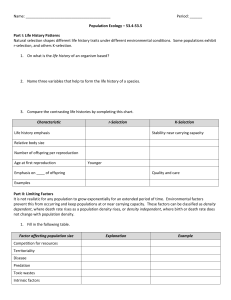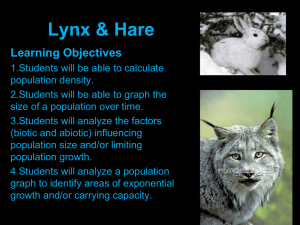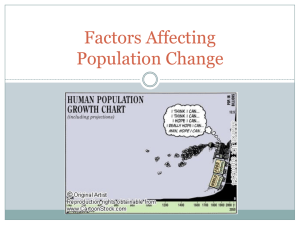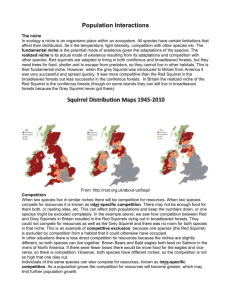Winter Prey Selection of Canada Lynx in Northwestern Montana Research Article
advertisement
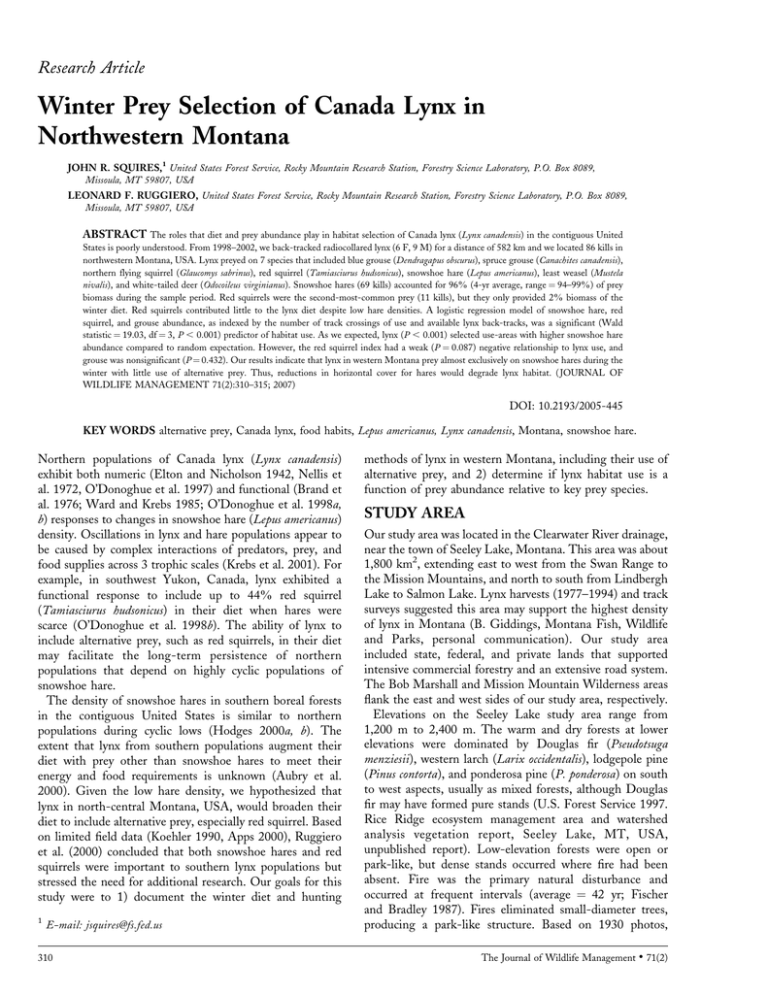
Research Article Winter Prey Selection of Canada Lynx in Northwestern Montana JOHN R. SQUIRES,1 United States Forest Service, Rocky Mountain Research Station, Forestry Science Laboratory, P.O. Box 8089, Missoula, MT 59807, USA LEONARD F. RUGGIERO, United States Forest Service, Rocky Mountain Research Station, Forestry Science Laboratory, P.O. Box 8089, Missoula, MT 59807, USA ABSTRACT The roles that diet and prey abundance play in habitat selection of Canada lynx (Lynx canadensis) in the contiguous United States is poorly understood. From 1998–2002, we back-tracked radiocollared lynx (6 F, 9 M) for a distance of 582 km and we located 86 kills in northwestern Montana, USA. Lynx preyed on 7 species that included blue grouse (Dendragapus obscurus), spruce grouse (Canachites canadensis), northern flying squirrel (Glaucomys sabrinus), red squirrel (Tamiasciurus hudsonicus), snowshoe hare (Lepus americanus), least weasel (Mustela nivalis), and white-tailed deer (Odocoileus virginianus). Snowshoe hares (69 kills) accounted for 96% (4-yr average, range ¼ 94–99%) of prey biomass during the sample period. Red squirrels were the second-most-common prey (11 kills), but they only provided 2% biomass of the winter diet. Red squirrels contributed little to the lynx diet despite low hare densities. A logistic regression model of snowshoe hare, red squirrel, and grouse abundance, as indexed by the number of track crossings of use and available lynx back-tracks, was a significant (Wald statistic ¼ 19.03, df ¼ 3, P , 0.001) predictor of habitat use. As we expected, lynx (P , 0.001) selected use-areas with higher snowshoe hare abundance compared to random expectation. However, the red squirrel index had a weak (P ¼ 0.087) negative relationship to lynx use, and grouse was nonsignificant (P ¼ 0.432). Our results indicate that lynx in western Montana prey almost exclusively on snowshoe hares during the winter with little use of alternative prey. Thus, reductions in horizontal cover for hares would degrade lynx habitat. ( JOURNAL OF WILDLIFE MANAGEMENT 71(2):310–315; 2007) DOI: 10.2193/2005-445 KEY WORDS alternative prey, Canada lynx, food habits, Lepus americanus, Lynx canadensis, Montana, snowshoe hare. Northern populations of Canada lynx (Lynx canadensis) exhibit both numeric (Elton and Nicholson 1942, Nellis et al. 1972, O’Donoghue et al. 1997) and functional (Brand et al. 1976; Ward and Krebs 1985; O’Donoghue et al. 1998a, b) responses to changes in snowshoe hare (Lepus americanus) density. Oscillations in lynx and hare populations appear to be caused by complex interactions of predators, prey, and food supplies across 3 trophic scales (Krebs et al. 2001). For example, in southwest Yukon, Canada, lynx exhibited a functional response to include up to 44% red squirrel (Tamiasciurus hudsonicus) in their diet when hares were scarce (O’Donoghue et al. 1998b). The ability of lynx to include alternative prey, such as red squirrels, in their diet may facilitate the long-term persistence of northern populations that depend on highly cyclic populations of snowshoe hare. The density of snowshoe hares in southern boreal forests in the contiguous United States is similar to northern populations during cyclic lows (Hodges 2000a, b). The extent that lynx from southern populations augment their diet with prey other than snowshoe hares to meet their energy and food requirements is unknown (Aubry et al. 2000). Given the low hare density, we hypothesized that lynx in north-central Montana, USA, would broaden their diet to include alternative prey, especially red squirrel. Based on limited field data (Koehler 1990, Apps 2000), Ruggiero et al. (2000) concluded that both snowshoe hares and red squirrels were important to southern lynx populations but stressed the need for additional research. Our goals for this study were to 1) document the winter diet and hunting 1 E-mail: jsquires@fs.fed.us 310 methods of lynx in western Montana, including their use of alternative prey, and 2) determine if lynx habitat use is a function of prey abundance relative to key prey species. STUDY AREA Our study area was located in the Clearwater River drainage, near the town of Seeley Lake, Montana. This area was about 1,800 km2, extending east to west from the Swan Range to the Mission Mountains, and north to south from Lindbergh Lake to Salmon Lake. Lynx harvests (1977–1994) and track surveys suggested this area may support the highest density of lynx in Montana (B. Giddings, Montana Fish, Wildlife and Parks, personal communication). Our study area included state, federal, and private lands that supported intensive commercial forestry and an extensive road system. The Bob Marshall and Mission Mountain Wilderness areas flank the east and west sides of our study area, respectively. Elevations on the Seeley Lake study area range from 1,200 m to 2,400 m. The warm and dry forests at lower elevations were dominated by Douglas fir (Pseudotsuga menziesii), western larch (Larix occidentalis), lodgepole pine (Pinus contorta), and ponderosa pine (P. ponderosa) on south to west aspects, usually as mixed forests, although Douglas fir may have formed pure stands (U.S. Forest Service 1997. Rice Ridge ecosystem management area and watershed analysis vegetation report, Seeley Lake, MT, USA, unpublished report). Low-elevation forests were open or park-like, but dense stands occurred where fire had been absent. Fire was the primary natural disturbance and occurred at frequent intervals (average ¼ 42 yr; Fischer and Bradley 1987). Fires eliminated small-diameter trees, producing a park-like structure. Based on 1930 photos, The Journal of Wildlife Management 71(2) forest patches with moderately open overstories were several hundred to thousands of hectares in size (U.S. Forest Service 1997. Rice Ridge ecosystem management area and watershed analysis vegetation report, Seeley Lake, Montana, USA, unpublished report). Timber harvest and fire suppression have shifted the open mature forests that were once most prevalent on low-elevation sites to forests of small-diameter, densely stocked stands. Low-elevation sites were usually ,35% slope. Mid-elevations supported primarily cool-moist to dry conifer forests. Dominant tree species included seral Douglas fir, western larch, and lodgepole pine in mixedto single-species stands. Infrequent, stand-replacing fires created even-aged stands that formed a mosaic of early seral to old-growth forests (Fischer and Bradley 1987). Slopes at mid-elevations were often .35%. Upper-elevation forests were mostly subalpine fir (Abies lasiocarpa), whitebark pine (Pinus albicaulis), and Engelmann spruce (Picea engelmannii) with lesser components of lodgepole pine, Douglas fir, and western larch. Subalpine forests were multi-storied and multi-aged, often with a dense shrub understory. Fire disturbances were infrequent and varied from small spot- to large stand-replacement fires depending on climatic conditions. Riparian vegetation varied from riparian grasses and sedges to shrub communities composed of dogwood (Cornus spp.), willow (Salix spp.), alder (Alnus spp.) and mixedconifer forests. Forested riparian areas were primarily subalpine fir, Engelmann spruce, Douglas fir, and black cottonwood (Populus balsamifera trichocarpa). METHODS Diet and Hunting Behavior From December 1998 to March 2002, we followed the snow trails of radiocollared lynx to determine their diet selection and hunting methods. We used radiotelemetry to locate collared individuals in sequence to distribute the sampling effort. Once located, we forward-tracked or back-tracked the animal for approximately 2–3 km depending on tracking conditions; we back-tracked away from lynx when in close proximity. We then located and identified prey remains and scavenging sites along lynx snowtracks to determine winter food habits. We believed this method was effective for identifying primary prey species, but we may have missed some small-bodied prey (e.g., mice [Peromyscus maniculatus], voles [Microtus spp.]) if lynx consumed it whole. To estimate the biomass of prey consumed, we multiplied the number of each prey item killed on back-tracks by the average mass of each species; the average mass we used in this calculation was northern flying squirrel (Glaucomys sabrinus; 108 g), red squirrel (195 g), grouse (blue grouse [Dendragapus obscurus], spruce grouse [Canachites canadensis], and ruffed grouse [Bonasa umbellus]; 900 g), and snowshoe hare (1,400 g; Wilson and Ruff 1999). We determined lynx hunting behavior in terms of chasing or ambushing prey based on track patterns in the snow. We measured the distance that lynx chased prey by pacing the Squires and Ruggiero Lynx Winter Diet Selection chase distance along the track. We also counted the number of bounds that lynx used to capture prey once the track sign indicated that prey was being pursued. Habitat Use Relative to Prey Indices We tallied the number of times that snowshoe hares, red squirrels, and grouse crossed tracks (use and available) as noncalibrated indices of prey abundance (Nichols 1986, Slade and Blair 2000, McKelvey and Pearson 2001). Concurrent to sampling the use track, we established an available track each day by randomly reorienting the start point and direction of a previously sampled use track within 3 km of the actual lynx track for that day. Thus, random tracks had the same general shape as actual lynx tracks to control for potential internal correlations due to track geometry, and our sampling of use and available tracks on the same day controlled for weather and snow effects. We then used Global Positioning System units to navigate to waypoints along random tracks to ensure we sampled the proper routes. We used logistic regression to model resource selection of lynx relative to the indices of snowshoe hare, red squirrel, and grouse abundance for descriptive rather than predictive purposes (Alldredge et al. 1998, Hosmer and Lemeshow 2000, Manly et al. 2002, Keating and Cherry 2004). We evaluated the aptness of the logistic model using Hosmer– Lemeshow goodness-of-fit test. Given that our data consisted of a few observations across many individuals, we pooled track-counts across individuals (White and Garrott 1990). However, to account for potential correlations within individuals, we used SAS GENMOD and the multivariable Wald test to estimate the exchangeable working correlation within individual lynx and to test the significance of the overall model (SAS Institute 1999). We initially forced all 3 prey indices into the original model before recalculating a reduced model that included only related (P . 0.25) variables (Hosmer and Lemeshow 2000). We interpreted the generalized estimating equation coefficients given the potential of correlation within individuals (Hosmer and Lemeshow 2000, SAS Institute 1999). RESULTS Winter Diet During the 4 winters of our study (1998–2002), we followed 240 snow tracks of radiocollared lynx (7 F, 10 M), each track averaging 2.4 km (SD ¼ 0.8 km) in length; we followed lynx paths for a total of 582 km. We located 86 lynx kills that included 7 prey species: blue grouse, spruce grouse, northern flying squirrel, red squirrel, snowshoe hare, least weasel (Mustela nivalis), and white-tailed deer (Odocoileus virginianus; Table 1). Snowshoe hares accounted for 69 kills and contributed 96% (4-yr average, range ¼ 94–99%) of prey biomass. Thus, lynx depended almost exclusively on snowshoe hares during winter. Red squirrels were the second-most-common prey (11 kills), but they only provided 2% biomass to the winter diet. Only one blue grouse and one spruce grouse kill were documented, indicating that grouse contributed little to the lynx diet. 311 Table 1. Winter food habits of Canada lynx, December 1998–March 2002, Seeley Lake, Montana, USA. No. of kills and % biomassa Prey species Grouse Northern flying squirrel Red squirrel Snowshoe hare Least weasel White-tailed deer 0 0 4 16 0 0 Winter Winter Winter Winter 1998–1999 1999–2000 2000–2001 2001–2002 Total N ¼ 21 N ¼ 17 N ¼ 26 N ¼ 22 N ¼ 86 3% 97% 0 1 1 14 0 2b 1 0 3 22 0 0 ,1% 1% 99% 3% 2% 95% 1 0 3 17 1 0 4% 2% 94% ,1% 2 1 11 69 1 2 2% ,1% 2% 96% ,1% a We estimated biomass based on the following estimates of prey body mass (Wilson and Ruff 1999): northern flying squirrel (108 g), red squirrel (195 g), grouse (900 g), and snowshoe hare (1,400 g). b We excluded white-tailed deer from biomass calculation because we could not determine the biomass of deer consumed by lynx alone. Lynx on 2 occasions killed white-tailed deer. Carrion was occasionally used by lynx; species scavenged included whitetailed deer, elk (Cervus elaphus), and a mountain lion (Puma concolor). Habitat Selection Relative to Prey Indices The median rate that we encountered snowshoe hare track crossings on lynx back-tracks was 3.1 hare crossings per 100 m (x̄ ¼ 4.7, SE ¼ 0.3, range ¼ 0–25, N ¼ 233 track pairs) compared to 2.1 per 100 m (x̄ ¼ 3.2, SE ¼ 0.2, range ¼ 0–22) on available tracks; this was the highest detection rate of any prey species on the study area (Table 2). Snowshoe hares were present on 99% of lynx tracks, indicating that hares were distributed throughout lynx foraging areas. Red squirrels were second in the number of detections, but the rate for squirrels was only 6% that of snowshoe hares. Lynx crossed red squirrel tracks at a median rate of 0.2 tracks per 100 m (x̄ ¼ 0.5, SE ¼ 0.04, range ¼ 0–5) on use tracks compared to 0.3 (x̄ ¼ 0.5, SE ¼ 0.04, range ¼ 0–4) on available tracks. Although red squirrels had a low detection rate relative to snowshoe hares, squirrels were present on 85% of lynx tracks, indicating they, too, were well distributed throughout lynx foraging areas. Grouse were present on only 10% of lynx tracks and were detected at a rate of ,0.01 crossings per 100 m for both use and available lynx tracks. A logistic regression model of prey indices (snowshoe hare, red squirrel, and grouse) was a strong (Wald statistic ¼ 19.03, df ¼ 3, P , 0.001) predictor of lynx habitat use on use compared to available sites in home ranges (Table 2). The exchangeable-working correlation within animal was low (0.02). This indicated that pooling across individuals was appropriate, as was the aptness of the overall logistic model based on the Hosmer and Lemeshow goodness-of-fit test (v28 ¼ 4.95, P ¼ 0.76). The snowshoe hare variable was the most important (P , 0.0001) predictor of lynx use (Table 2). Red squirrels had a weak (P ¼ 0.09) negative relationship to lynx use areas, whereas grouse were not a factor (P ¼ 0.43). The reduced model that considered only snowshoe hare and red squirrel was also a significant (Wald statistic ¼ 19.03, df ¼ 2, P , 0.001) predictor of lynx habitat use 312 (Table 2). Lynx strongly (P , 0.001) selected use areas with higher snowshoe hare abundance compared to random expectation (Table 2). Ninety-four percent (15 of 16 lynx) of individual lynx selected areas with a greater abundance of snowshoe hare tracks compared to random sites within their home ranges, which supported the model result (Table 3). Red squirrels continued to have a weak (P ¼ 0.06) negative relationship with habitat use, suggesting that lynx did not select use areas based on red squirrels. Only 25% of individual lynx crossed squirrel tracks at a rate higher than random expectation (Table 3). Hunting Methods Snowshoe hare kills were encountered at the rate of one kill per 8.4 km of lynx snow tracks (69 hare kills/582 km of lynx tracks); the overall encounter rate for all prey species was one kill per 6.8 km of lynx snow tracks. Snow-tracking conditions were adequate to identify hunting methods at 84% (58 of 69) of hare kills. Of these kills, 45% (26 of 58) of hares were ambushed and 55% (32 of 58) were captured following a chase. During successful chases, lynx pursued hares an average of 33 m (SD ¼ 29, N ¼ 29 chases with complete distances measured) before capture, with chase Table 2. Logistic regression with associated generalized estimating equation parameter estimates of prey indices on lynx tracks (N ¼ 233 pairs) compared to random expectation, 1998–2002, Seeley Lake, Montana, USA. Variable Coeff. ^bi SE 95% CI Z score P-value a Full model Intercept 0.462 0.016 0.430 0.494 28.08 ,0.0001 Snowshoe hare 0.020 0.004 0.012 0.029 4.91 ,0.0001 Red squirrel 0.059 0.034 0.126 0.009 1.71 0.087 Grouse 0.230 0.292 0.802 0.343 0.79 0.432 Reduced modelb Intercept 0.465 0.015 0.437 0.494 32.12 ,0.0001 Snowshoe hare 0.020 0.004 0.012 0.027 5.09 ,0.0001 Red squirrel 0.064 0.034 0.131 0.002 1.90 0.057 a Wald test of global null hypothesis full model (v2 ¼ 19.04, df ¼ 3, P , 0.001). b Wald test of global null hypothesis reduced model (v2 ¼ 19.04, df ¼ 2, P , 0.001). The Journal of Wildlife Management 71(2) Table 3. Number of prey tracks than crossed lynx-use and random back-tracks by individual, Seeley Lake, Montana, USA, 1998–2002. Snowshoe hare track crossings/100 m Lynx a Use b ID N F01 F10 F14 F18 F40 F55 F70 M02 M04 M05 M06 M07 M26 M32 M81 M85 Mean 16 20 19 5 16 11 16 16 22 8 10 19 18 17 10 9 233 a b Random Median 2.9 3.7 3.2 6.8 3.6 1.5 3.2 5.2 2.7 3.5 2.1 2.8 4.4 5.4 3.8 2.8 3.1 Red squirrel track crossings/100 m Range 0 1 0 0 0 0 1 0 0 0 0 0 0 0 0 1 0 20 13 15 26 20 12 13 17 16 6 5 14 15 15 8 11 26 Median 2.2 2.9 1.4 2.3 2.1 1.1 3.6 2.4 1.7 3.2 0.9 2.1 2.3 2.8 3.5 0.7 2.1 Use Range 0 0 0 2 0 0 0 0 0 0 0 0 0 0 0 0 0 5 22 13 14 13 7 9 12 12 8 5 11 12 11 12 7 22 Random Median 0.1 0.5 0.3 0.3 0.1 0.3 0.1 0.3 0.2 0.1 0.4 0.2 0.4 0.2 0.5 0.2 0.2 Range 0 0 0 0 0 0 0 0 0 0 0 0 0 0 0 0 0 Median 5 3 2 1 1 4 1 3 3 1 2 2 3 1 1 2 5 0.5 0.5 0.1 0.4 0.3 0.3 0.3 0.7 0.3 0.2 0.2 0.3 0.7 0.1 1.2 0.2 0.3 Range 0 0 0 0 0 0 0 0 0 0 0 0 0 0 0 0 0 3 1 1 0.5 3 2 2 4 2 1 1 2 2 1 3 1 4 ID ¼ identification no. M03 excluded from table because only back-tracked once. N ¼ no. of use and random track-pairs/animal. distances that ranged from 4 m to 117 m. Lynx averaged 2.4 m (SD ¼ 0.6 m, N ¼ 29) per bound when chasing hares. We determined the hunting methods used by lynx to kill red squirrels at 9 of 11 kill sites. Lynx ambushed red squirrels at 8 of 9 kills and only once was a squirrel killed following a chase. Lynx took one to 2 bounds over a distance of 2–3 m when ambushing squirrels. We documented 2 instances of lynx killing white-tailed deer (Table 1). Based on snow tracks observed on 14 December 1999, an adult male lynx ambushed and killed a female as she walked uphill from a streambed. The deer’s head and neck were lacerated with claw and bite wounds with extensive hemorrhaging; bone marrow from the deer’s leg suggested the animal was in good condition prior to the attack. This deer may have been more vulnerable to lynx predation because recent snowstorms deposited about 29 cm of powder snow that resulted in a 0.5-m snowpack. On 22 January 2000, the same male killed an 8-month-old deer. Large amounts of blood in the snow indicated that the deer was attacked and killed as it ran or rolled down a hill. This animal was also in good body condition. In both cases, the male fed on the deer carcasses for several days. DISCUSSION The preponderance of snowshoe hare biomass (x̄ ¼ 96%) in the winter diet of lynx at Seeley Lake was consistent with documented diets of lynx from northern (Mowat et al. 2000) and southern (Aubry et al. 2000) populations. This result was hardly surprising given that lynx are quintessential hare predators with morphological adaptations that are highly specialized for hunting hares in deep snow (Murray and Boutin 1991). However, diet studies of northern and other southern lynx populations have documented dietary shifts to include alternative prey, such as red squirrel, when hare Squires and Ruggiero Lynx Winter Diet Selection densities were low (Koehler 1990, Apps 2000, Mowat et al. 2000). For example, in southwestern Yukon, Canada, O’Donoghue et al. (1998b) found that red squirrel composed 20–44% of prey biomass during years of lowest hare density (,0.2 hare/ha as estimated from presented data) and 0–4% of prey biomass during years of high hare abundance (approx. 2 hares/ha); the use of small mammals as alternative prey was negligible during all winters. Given the apparent relationship between hare density and the use of alternative prey (O’Donoghue et al. 1998b, Mowat et al. 2000), we assumed the degree that lynx in western Montana depended on alternative prey would be strongly influenced by hare density. From 1999–2003, Griffin (2004) estimated snowshoe hare densities using mark–recapture methods on our Seeley Lake study area. Griffin documented summer hare densities in 4 general habitat types: 1) mature, dense forests (0.34 hares/ha, SD ¼ 0.41), 2) mature, open forests (0.18 hares/ha, SD ¼ 0.28), 3) young, dense forests (0.64 hares/ha, SD ¼ 0.44), and 4) young, open forests (0.18 hares/ha, SD ¼ 0.19). Griffin also estimated hare densities during 2 winters and found: 1) mature, dense forests (0.53 hares/ha, SD ¼ 0.53), 2) mature, open forests (0.20 hares/ha, SD ¼ 0.44), 3) young, dense forests (0.47 hares/ha, SD ¼ 0.41), and 4) young, open forests (0.12 hares/ha, SD ¼ 0.17). Thus, hare densities at Seeley Lake were low (approx. 0.1–0.6 hares/ha) throughout the duration of our study, regardless of season or habitat type. The low hare densities at Seeley Lake were consistent with other southern populations (Hodges 2000b). Lynx at Seeley Lake failed to exhibit a functional diet shift to include many red squirrels in their winter diet. This result differed from the only 2 prior studies of lynx food habits in the northern Rocky Mountains. In Washington, USA, Koehler (1990) found that 23 of 29 (79%) scats that were 313 collected during winter and summer contained snowshoe hare and 7 (24%) contained red squirrel. In southern British Columbia, Canada, Apps (2000) back-tracked lynx and found that winter kills (n ¼ 137) included 52% snowshoe hare, 30% red squirrel, 5% northern flying squirrel, and 4 other species that contributed 3% of the diet. Although hare densities were low (0.1–0.6 hares/ha) at Seeley Lake (Griffin 2004), they apparently were adequate to preclude lynx from shifting their diet to red squirrels. The tracks of red squirrel were crossed 9 times less frequently than snowshoe hares. Although actual squirrel densities were unknown, red squirrels were widely distributed throughout lynx foraging areas. Lynx can also shift their diet to include a greater proportion of grouse and other birds in response to low hare densities (Brand et al. 1976). At Seeley Lake, grouse crossed only 10% of lynx tracks at a low rate of 0.01 crossings per 100 m (use and available tracks). We assumed the low proportion of grouse in the winter diet was due to their scarcity on the study area, as confirmed by the few grouse we observed during winter fieldwork. Thus, snowshoe hare and red squirrel were the only prey species that were relatively common and well distributed across lynx foraging areas. White-tailed deer were common only at low elevations during winter, but predation on this species appeared to be highly opportunistic when deer were encumbered by deep snow. Results from logistic modeling indicated that prey indices were significant (P , 0.001) predictors of lynx habitat use. Lynx exhibited strong preferential selection for areas with greater hare densities compared to random availability within home ranges. However, red-squirrel abundance was not a factor in lynx habitat selection as evidenced by similar crossing rates on both use (0.2 crossings/100 m) and available (0.3/100 m) tracks within home ranges. It is possible that red squirrels were poorly indexed by trackcounts due to their territoriality or their general low density (Gurnell 1984). However, this potential bias was similar between use and available sites. Thus, we concluded based on food habits and logistic modeling, that lynx foraging and habitat selection was strongly driven by the abundance of snowshoe hares, and that red squirrels were only killed opportunistically. Ruggiero et al. (2000) provided ‘‘qualified insights’’ that were an attempt to distill the most salient understandings of lynx management, given our limited knowledge of lynx in the contiguous United States. These statements affect lynx management because federal agencies, like the United States Forest Service, use these understandings when formulating management plans across the United States. Ruggiero and his colleagues concluded that snowshoe hares are the dominant prey of lynx in the contiguous United States, and that red squirrels are important alternative prey when hares are scarce. As such, they recommend that managers provide forested landscapes with high horizontal cover for hares and late-succession patches with cone-bearing trees and coarse woody debris for red squirrels. 314 Our results support the notion that lynx in western Montana prey almost exclusively on snowshoe hares during the winter, and it follows that maintaining landscapes with low, dense horizontal structure for hares is important (Hodges 2000a, b). We do not understand the extent and duration of fluctuations in southern hare populations (Hodges 2000b). If we assume that red squirrels are the only plausible emergency food available to lynx during periods of low hare densities, then maintaining latesuccessional forests with cone-bearing trees for squirrels (Klenner and Krebs 1991, Larsen and Boutin 1995, Ruggiero et al. 2000) could play a role in the long-term persistence of southern lynx populations. Nevertheless, we could not assess this relationship given that hare populations appeared stable during our study (Griffin 2004). Lynx at Seeley Lake used ambush (45% of kills) and chase (55%) methods to kill hares. Lynx from northern populations also used ambush and chase methods to secure prey depending on the density of prey (Saunders 1963, Murray et al. 1995, O’Donoghue et al. 1998a). In southwest Yukon, Canada, O’Donoghue et al. (1998a) found that lynx ambushed prey from hunting beds most often during cyclic declines and lows in prey populations, and Murray et al. (1995) found that hunting success was considerably higher for ambushed versus not ambushed attacks. It was unclear why lynx at Seeley Lake mostly chased rather than ambushed snowshoe hares given the low hare density. Possibly, vegetation structure at Seeley Lake favored lynx chasing prey, or although hare densities were low, they were sufficient for chase hunting to be energetically profitable. Conversely, red squirrels were ambushed most (89%) of the time, usually as they traveled the snow crests between tree wells. MANAGEMENT IMPLICATIONS Our results indicated that lynx in western Montana prey almost exclusively on snowshoe hares during winter given current hare densities. Thus, it follows that managers should provide forests with dense horizontal cover for hares (Hodges 2000a, b), and management practices that reduce horizontal cover, such as forest thinning, degrades lynx habitat. We found little evidence that alternative prey, like red squirrels, contributed to the winter diet despite low hare densities (0.1–0.6 hares/ha). Given that hare populations were stable during our study (Griffin 2004), we could not test whether lynx would exhibit a functional shift to include more alternative prey if hare densities fell below observed levels. ACKNOWLEDGMENTS We acknowledge the technicians that assisted with field data collection. Research was funded by the Rocky Mountain Research Station, Forestry Sciences Laboratory, Missoula, Montana. We thank Plum Creek Timber Company and the Bureau of Land Management for additional financial support; we also thank Montana Fish, Wildlife, and Parks, and the Seeley Lake District, United States Forest Service The Journal of Wildlife Management 71(2) for their cooperation and logistical support. We thank D. Pearson, N. DeCesare, and J. Kolbe for reviewing early drafts of the manuscript; we also thank R. King for providing statistical review. LITERATURE CITED Alldredge, J. R., D. L. Thomas, and L. L. McDonald. 1998. Survey and comparison of methods of study of resource selection. Journal of Agricultural, Biological and Environmental Statistics 3:237–253. Apps, C. D. 2000. Space-use, diet, demographics, and topographic associations of lynx in the southern Canadian Rocky Mountains: a study. Pages 351–371 in L. F. Ruggiero, C. Krebs, K. B. Aubry, S. W. Buskirk, G. M. Koehler, K. S. McKelvey, J. R. Squires, and C. J. Krebs, editors. Ecology and conservation of lynx in the United States. University of Colorado Press, Boulder, USA. Aubry, K. B., G. M. Koehler, and J. R. Squires. 2000. Ecology of Canada lynx in southern boreal forests. Pages 373–396 in L. F. Ruggiero, C. Krebs, K. B. Aubry, S. W. Buskirk, G. M. Koehler, K. S. McKelvey, J. R. Squires, and C. J. Krebs, editors. Ecology and conservation of lynx in the United States. University of Colorado Press, Boulder, USA. Brand, C. J., L. B. Keith, and C. A. Fischer. 1976. Lynx responses to changing snowshoe hare densities in central Alberta. Journal of Wildlife Management 40:416–428. Elton, C., and M. Nicholson. 1942. The ten-year cycle in numbers of lynx in Canada. Journal of Animal Ecology 11:215–244. Fischer, W. C., and A. F. Bradley. 1987. Fire ecology of western Montana forest habitat types. U.S. Forest Service, Intermountain Research Station, General Technical Report INT-223, Ogden, Utah, USA. Griffin, P. C. 2004. Landscape ecology of snowshoe hares in Montana. Dissertation, University of Montana, Missoula, USA. Gurnell, J. 1984. Home range, territoriality, caching behaviour and food supply of the red squirrel (Tamiasciurus hudsonicus fremonti) in a subalpine lodgepole pine forest. Animal Behavior 32:1119–1131. Hodges, K. E. 2000a. The ecology of snowshoe hares in northern boreal forests. Pages 117–161 in L. F. Ruggiero, C. Krebs, K. B. Aubry, S. W. Buskirk, G. M. Koehler, K. S. McKelvey, J. R. Squires, and C. J. Krebs, editors. Ecology and conservation of lynx in the United States. University of Colorado Press, Boulder, USA. Hodges, K. E. 2000b. Ecology of snowshoe hares in southern boreal and montane forests. Pages 163–206 in L. F. Ruggiero, C. Krebs, K. B. Aubry, S. W. Buskirk, G. M. Koehler, K. S. McKelvey, J. R. Squires, and C. J. Krebs, editors. The ecology and conservation of lynx in the United States. University of Colorado Press, Boulder, USA. Hosmer, D. W., and S. Lemeshow. 2000. Applied logistic regression. Second edition. John Wiley and Sons, New York, New York, USA. Keating, K. A., and S. Cherry. 2004. Use and interpretation of logistic regression in habitat selection studies. Journal of Wildlife Management 68:774–789. Klenner, W., and C. J. Krebs. 1991. Red squirrel population dynamics. I. The effect of supplemental food on demography. Journal of Animal Ecology 60:961–978. Koehler, G. M. 1990. Population and habitat characteristics of lynx and snowshoe hares in north central Washington. Canadian Journal of Zoology 68:845–851. Krebs, C. J., R. Boonstra, S. Boutin, and A. R. E. Sinclair. 2001. What drives the 10-year cycle of snowshoe hares? BioScience 51:25–35. Squires and Ruggiero Lynx Winter Diet Selection Larsen, K. W., and S. Boutin. 1995. Exploring territory quality in the North American red squirrel through removal experiments. Canadian Journal of Zoology 73:1115–1122. Manly, B. F. J., L. L. McDonald, D. L. Thomas, and W. Erickson. 2002. Resource selection by animals. Second edition. Kluwer Press, New York, New York, USA. McKelvey, K. S., and D. E. Pearson. 2001. Population estimation with sparse data: the role of estimators versus indices revisited. Canadian Journal of Zoology 79:1754–1765. Mowat, G., K. G. Poole, and M. O’Donoghue. 2000. Ecology of lynx in northern Canada and Alaska. Pages 265–306 in L. F. Ruggiero, C. Krebs, K. B. Aubry, S. W. Buskirk, G. M. Koehler, K. S. McKelvey, J. R. Squires, and C. J. Krebs, editors. The ecology and conservation of lynx in the United States. University of Colorado Press, Boulder, USA. Murray, D. L., and S. Boutin. 1991. The influence of snow on lynx and coyote movements: does morphology affect behavior? Oecologia 88:463– 469. Murray, D. L., S. Boutin, M. O’Donoghue, and V. O. Nams. 1995. Hunting behavior of a sympatric felid and canid in relation to vegetative cover. Animal Behavior 50:1203–1210. Nellis, C. H., S. P. Wetmore, and L. B. Keith. 1972. Lynx–prey interaction in central Alberta. Journal of Wildlife Management 36:320–329. Nichols, J. D. 1986. On the use of enumeration estimators for interspecific comparisons, with comments on a ‘‘trappability’’ estimator. Journal of Mammalogy 67:590–593. O’Donoghue, M., S. Boutin, C. J. Krebs, and E. J. Hofer. 1997. Numerical responses of coyotes and lynx to the snowshoe hare cycle. Oikos 80:150– 162. O’Donoghue, M., S. Boutin, C. J. Krebs, D. L. Murray, and E. J. Hofer. 1998a. Behavioural responses of coyotes and lynx to the snowshoe hare cycle. Oikos 82:169–183. O’Donoghue, M., C. J. Krebs, G. Zuleta, D. L. Murray, and E. J. Hofer. 1998b. Functional responses of coyotes and lynx to the snowshoe hare cycle. Ecology 79:1193–1208. Ruggiero, L. F., K. B. Aubry, S. W. Buskirk, G. M. Koehler, C. J. Krebs, K. S. McKelvey, and J. R. Squires. 2000. The scientific basis for lynx conservation: qualified insights. Pages 443–454 in L. F. Ruggiero, C. Krebs, K. B. Aubry, S. W. Buskirk, G. M. Koehler, K. S. McKelvey, J. R. Squires, and C. J. Krebs, editors. Ecology and conservation of lynx in the United States. University of Colorado Press, Boulder, USA. SAS Institute. 1999. SAS user’s guide. Version 8. SAS Institute, Cary, North Carolina, USA. Saunders, J. K. 1963. Food habits of lynx in Newfoundland. Journal of Wildlife Management 27:384–390. Slade, N. A., and S. M. Blair. 2000. An empirical test of using counts of individuals captured as indices of population size. Journal of Mammalogy 81:1035–1045. Ward, R. M. P., and C. J. Krebs. 1985. Behavioural responses of lynx to declining snowshoe hare abundance. Canadian Journal of Zoology 63: 2817–2824. White, G. C., and R. A. Garrott. 1990. Analysis of wildlife radiotracking data. Academic Press, San Diego, California, USA. Wilson, D. E., and S. Ruff. 1999. The Smithsonian book of North American mammals. Smithsonian Institution Press in association with the American Society of Mammalogists, Washington, D.C., USA, and London, United Kingdom. Associate Editor: Smallwood. 315
